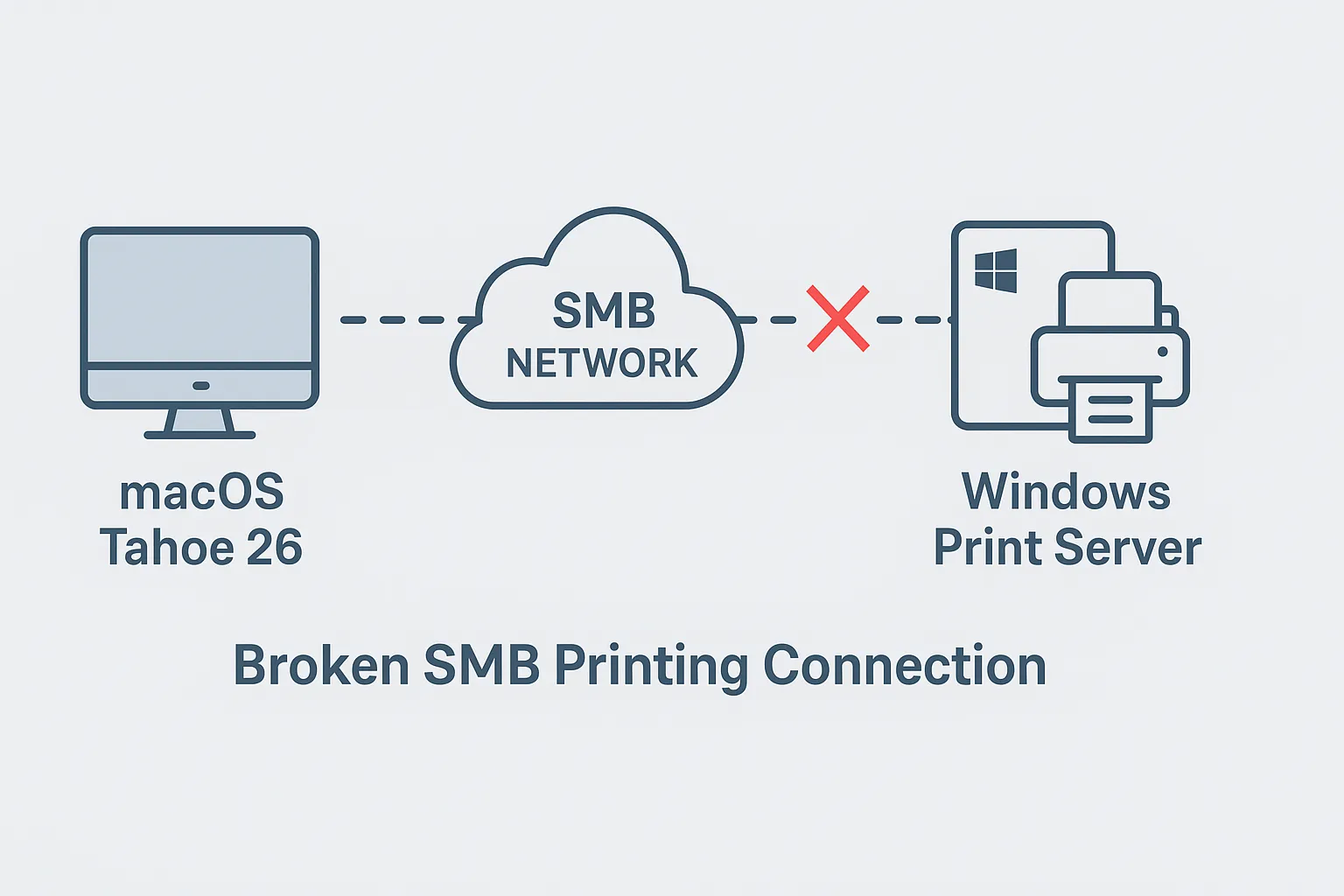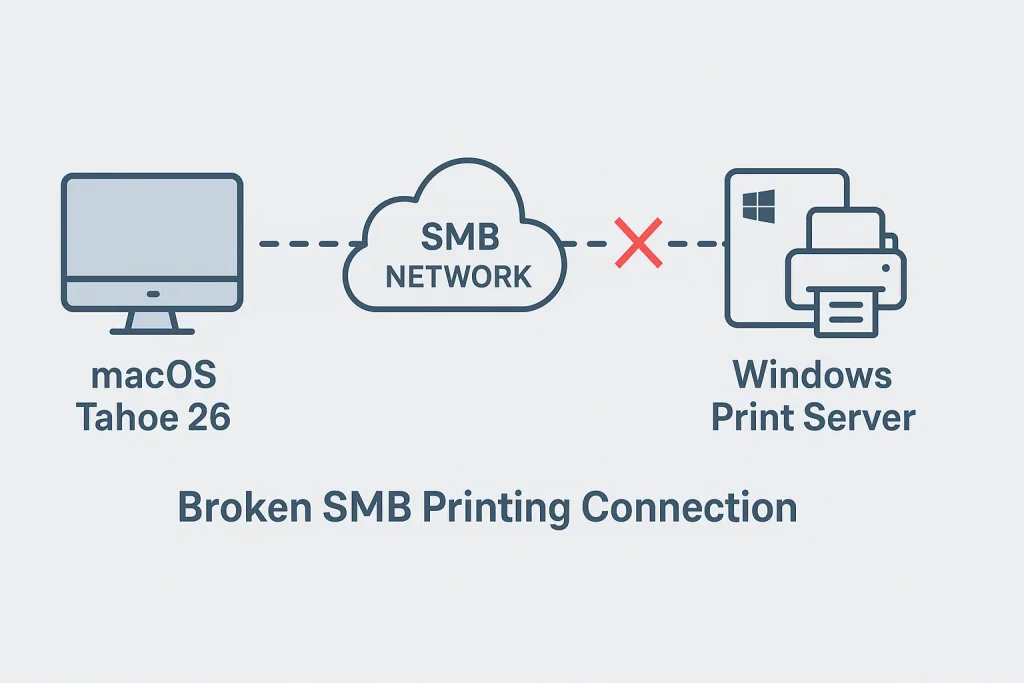
After updating to macOS Tahoe 26, many users are experiencing SMB printing issues — particularly when connecting to shared printers on Windows PCs or print servers.
You might see errors like “Cannot connect to printer,” “SMB authentication failed,” or “Printer not responding.” Everything worked fine before the update, but suddenly the connection keeps timing out or rejecting your credentials.
This happens because Apple made major changes to SMB security and authentication protocols in Tahoe 26. The update tightened name resolution, removed older SMB versions, and changed how credentials are stored in Keychain.
In this guide, I’ll walk you through step-by-step fixes that work — tested by real users — so your printer gets back online fast.

1. Understand Why SMB Printing Broke After the Update
The issue isn’t your printer — it’s how macOS Tahoe now communicates via SMB.
Here’s what changed under the hood:
- SMBv1 support is gone — Tahoe enforces SMB 3.x only.
- IP-based SMB connections are less reliable due to DNS authentication checks.
- Cached credentials in Keychain may no longer match the domain server.
- MIDI and I/O configuration resets can break shared device mapping.
If you’re using a Windows print server or a shared printer on another PC, these updates can cause the connection to fail until you adjust the path and authentication method.
✅ Read my setup guide — [How to use SMB printing on macOS] — to understand how SMB printers are added and authenticated.
2. Fix #1: Use FQDN Instead of IP Address (Most Effective Fix)
This is the first thing you should try — and for most users, it fixes the issue completely.
Instead of connecting using an IP address like this:
smb://192.168.1.12/HP_OfficeJet
Use the Fully Qualified Domain Name (FQDN) of your print server:
smb://printserver.domain.com/HP_OfficeJet
Using the FQDN allows macOS to authenticate properly through DNS lookup and domain mapping. It also matches Apple’s new SMB authentication model introduced in Tahoe 26.
If your network doesn’t have DNS entries for your printer or print server, add one manually to your Mac’s /etc/hosts file:
- Open Terminal.
- Run this command:
sudo nano /etc/hosts - Add this line, replacing IP and domain with your setup:
192.168.1.12 printserver.domain.com - Save with Ctrl + O, then Enter, and exit with Ctrl + X.
Restart your Mac and reconnect to the printer using the FQDN path.
Why it works:
macOS Tahoe relies on proper hostname resolution to map SMB credentials. IP-only connections skip this process, leading to failed logins or untrusted certificate warnings.
3. Fix #2: Reconnect Using Correct SMB Credentials
After a major macOS update, old SMB credentials in Keychain often become invalid. You’ll need to remove and re-add them.
Here’s how:
- Open Keychain Access (press Command + Space, type “Keychain Access”).
- Search for smb.
- Delete any stored entries related to your printer or server.
- Reconnect your printer using this path format:
smb://username@printserver.domain.com/share - When prompted, enter your password and check “Remember this password in Keychain.”
This ensures macOS uses your new credentials correctly under the Tahoe 26 security model.
✅ See detailed instructions — [Mac connect to SMB with username and password] — for proper login and Keychain management.
4. Fix #3: Re-Add the Printer Manually
If your printer still doesn’t respond, try re-adding it from scratch:
- Go to System Settings > Printers & Scanners.
- Click the + button to add a printer.
- Choose Windows Printer via SMB.
- Enter your FQDN-based address (e.g.,
smb://printserver.domain.com/share). - When selecting a driver, choose the correct PostScript or PCL driver instead of AirPrint if available.
This ensures macOS communicates properly through the SMB protocol instead of generic printing over IP.
5. Fix #4: Test SMB Connectivity
Before blaming the printer, confirm that SMB is working correctly on your Mac.
- Open Terminal.
- Type the following command and hit Return:
smbutil view //username@printserver.domain.com
If you see a list of shared folders (including your printer name), the connection is working.
If it fails, you may have DNS, network, or firewall issues blocking SMB.
6. Fix #5: Reset the Print System
Sometimes macOS caching causes the printer queue to hang.
To reset everything:
- Go to System Settings > Printers & Scanners.
- Right-click (or Control-click) the printer list.
- Choose Reset Printing System…
- Reboot your Mac and re-add the printer using the steps above.
This clears old SMB routes, cached device profiles, and permissions.
7. Fix #6: Check Firewall or Network Filters
If you’re on a managed network, firewalls or VPNs might block SMB ports (445 or 139).
- Go to System Settings > Network > Firewall.
- Temporarily turn off the firewall to test.
- If using a VPN, disconnect and try printing locally first.
Once confirmed, re-enable your security settings.
8. Fix #7: Adjust SMB Signing (Advanced Users)
Some enterprise print servers still use older signing policies that conflict with Tahoe’s stricter SMB signature requirements.
If you’re in an enterprise setup, contact your IT team to adjust SMB signing policies or domain controller compatibility. For experienced users, you can manually test configuration adjustments using nsmb.conf, but this should be done cautiously.
9. Fix #8: Update or Patch the Windows Print Server
In many cases, the Windows print server itself needs a patch or SMB configuration update.
Encourage readers to check for updates or coordinate with their admin teams.
Many IT admins confirmed that switching to FQDN printing solved the issue permanently.
Pro Tip: Verify Your macOS Printer Sharing Settings
If you also share printers from your Mac, double-check:
- System Settings > General > Sharing > Printer Sharing is enabled.
- Add the correct users or groups.
- Ensure SMB sharing is active under File Sharing > Options > Share files and printers using SMB.
Quick Recap
| Problem | Cause | Fix |
|---|---|---|
| Printer not found | macOS can’t resolve IP-based path | Use FQDN like smb://printserver.domain.com/share |
| Authentication failed | macOS can’t resolve the IP-based path | Remove old Keychain entries and reconnect |
| “Printer not responding” | Driver reset or wrong protocol | Re-add as “Windows Printer via SMB” |
| SMB test fails | Network or DNS issue | Use smbutil view to test |
| Persistent issue | Corrupted print queue | Reset printing system |
Final Thoughts
It’s clear that macOS Tahoe 26 introduced stricter SMB handling — improving security but also breaking old printer configurations.
The good news is that the most common fix — switching from IP to FQDN and refreshing credentials — solves the problem for most users.
If you’re managing multiple Macs in an office setup, consider creating /etc/hosts entries for all print servers and keeping credentials synced with Keychain.
Your Turn
Did one of these fixes help you restore SMB printing on macOS Tahoe 26? Please leave your reaction or experience below — it helps the community find what really works faster.





